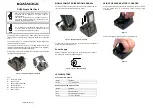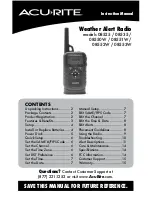
8
If the LED flashes repeatedly but your console isn’t picking up a signal anywhere in
the room, it could be related to one of the following causes:
• The DIP switches were not correctly set on the transmitter. Review the procedure
on page 5.
• The ID was not correctly set on the console/receiver. Review the procedure on
page 6.
• Reception is being disrupted by RF (radio frequency) interference.
• There is a problem with the console/receiver. See “Contacting Davis Technical
Support” on page 19.
Note:
Remember to turn DIP switch #4 OFF when you’re finished testing wireless transmission. If it is
left ON, the blinking LED will reduce battery life significantly.
Choosing a Location to Mount the Station
Try to position your Leaf/Soil Station as follows:
• With the solar panel positioned for maximum exposure to the sun.
• Within transmission range of your Vantage Pro2 console.See “Range of Wireless
Transmission” on page 8.
• Within cable range of the sensors:
•
Leaf Wetness Sensors come with 40’ (12 m) of cable standard and can be
extended up to 200’ (61m) using 6-conductor 26 AWG cable.
•
Soil Moisture Sensors come with 15’ (4.6 m) of cable standard and can be
extended up to 1000’ (300m) using #18 gauge UF cable.
•
Temperature Sensors come with 15’ (4.6 m) of cable standard and can be
extended up to 800’ (242m) using #24 AWG shielded cable or up to 1200’
(260m) using #22 AWG shielded cable.
Range of Wireless Transmission
The range of wireless transmission depends on many factors. For the best reception,
position the transmitter shelter and your console/receiver as close together as possi-
ble.
The maximum range is up to 1,000' (300 m) in the line of sight, under optimal con-
ditions. Typical range under most conditions is 200' to 400' (75 to 150 m), but this
may be reduced by walls, ceilings, trees, or foliage. Radio-frequency interference
(RF) can also reduce transmission distance. Cordless phones and baby monitors are
common examples of devices that can cause RF interference.
A metal roof or other large metal structure can interfere with the signal. Aluminum
siding, a furnace with metal ducts, and your refrigerator are examples. Sometimes
transmission between wireless units is obscured by something you cannot identify,
or by some obstacle that you can’t work around. If necessary, consider using Wire-
less Repeater #7626 or #7627 to strengthen the signal or increase the distance
between the transmitter and the console/receiver.






































